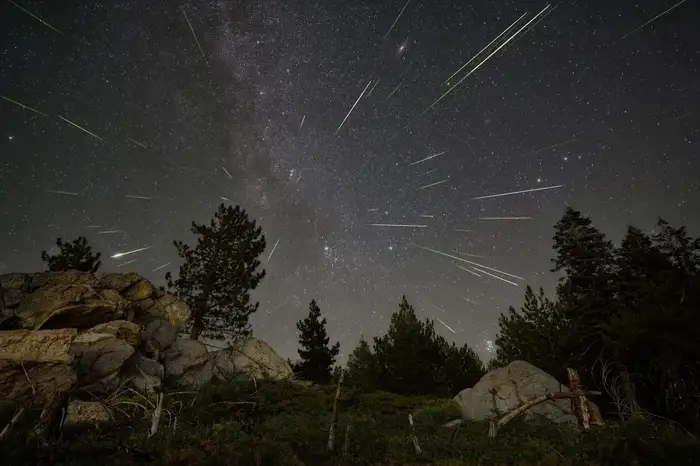The Perseids meteor shower, one of the year’s most anticipated celestial events, is set to light up the night sky this weekend. Known for its bright fireballs and colorful tails, this meteor shower is widely regarded as the best of the year, according to NASA. Alongside this dazzling display, a planetary conjunction of Jupiter and Mars will also be visible to the naked eye, making this weekend an ideal time for stargazers.
The Perseids meteor shower occurs annually as Earth passes through the trail of dust and debris left behind by the comet Swift-Tuttle. As these particles enter Earth’s atmosphere, they burn up, creating spectacular streaks of light across the sky. The Perseids are particularly famous for their long, lingering tails and the occasional fireball—an especially bright meteor that stands out against the night sky.
This year, viewing conditions are expected to be exceptional. With the moon setting around midnight, the skies will be dark, providing an optimal backdrop for the meteor shower. NASA estimates that under ideal conditions, you might see between 50 to 100 meteors per hour, or about one to two meteors every minute.
Adding to the excitement, the Perseids will be accompanied by a close appearance of Jupiter and Mars in the pre-dawn skies. These two planets will be visible side by side, giving stargazers a rare opportunity to witness this planetary conjunction. The best time to view them is early in the morning, starting around 2 a.m., when they will rise between the horns of the Taurus constellation. Mars will have a reddish hue, while Jupiter will shine brightly nearby.
For those in northern parts of the U.S., there is also a chance to catch a glimpse of the northern lights, or aurora borealis, particularly on Friday and Saturday nights. This natural light display could be visible from states like New York to Idaho, adding yet another reason to step outside and look up this weekend.
The best part about all these celestial events is that no special equipment is needed. Whether you’re an experienced astronomer or a casual sky-watcher, all you need is a clear view of the night sky. Find a spot away from city lights with a wide-open view, and bring a picnic blanket or a reclining lawn chair for comfort. It’s important to give your eyes about 20 minutes to adjust to the darkness, and try to avoid looking at your phone, as it can disrupt your night vision.
The peak viewing time for the Perseids will be in the early morning hours of Sunday and Monday. However, the meteors will still be visible in smaller numbers for a few days before and after the peak. They are best seen from the Northern Hemisphere, but can be spotted worldwide.
If you’re unable to get outside or live in an area with too much light pollution, you can still enjoy the meteor shower online. The Virtual Telescope Project will be streaming a live broadcast from its all-sky camera in Manciano, Italy, which boasts some of the darkest skies in the country. The livestream will be available on Sunday and Monday starting at 9 p.m. ET, allowing you to experience the Perseids from the comfort of your home.
Also Read:
- Tom Cruise and Other Big Names at the Olympics Closing Ceremony: What You Need to Know
- Simone Biles and Rebeca Andrade Showcase Peak Performance at Advanced Ages in Olympics
In summary, this weekend offers a unique opportunity to witness some of the most stunning natural displays in the sky. With the Perseids meteor shower, a Jupiter-Mars conjunction, and the potential for northern lights, there’s plenty to look forward to. So, grab a blanket, head outside, and enjoy the show.






